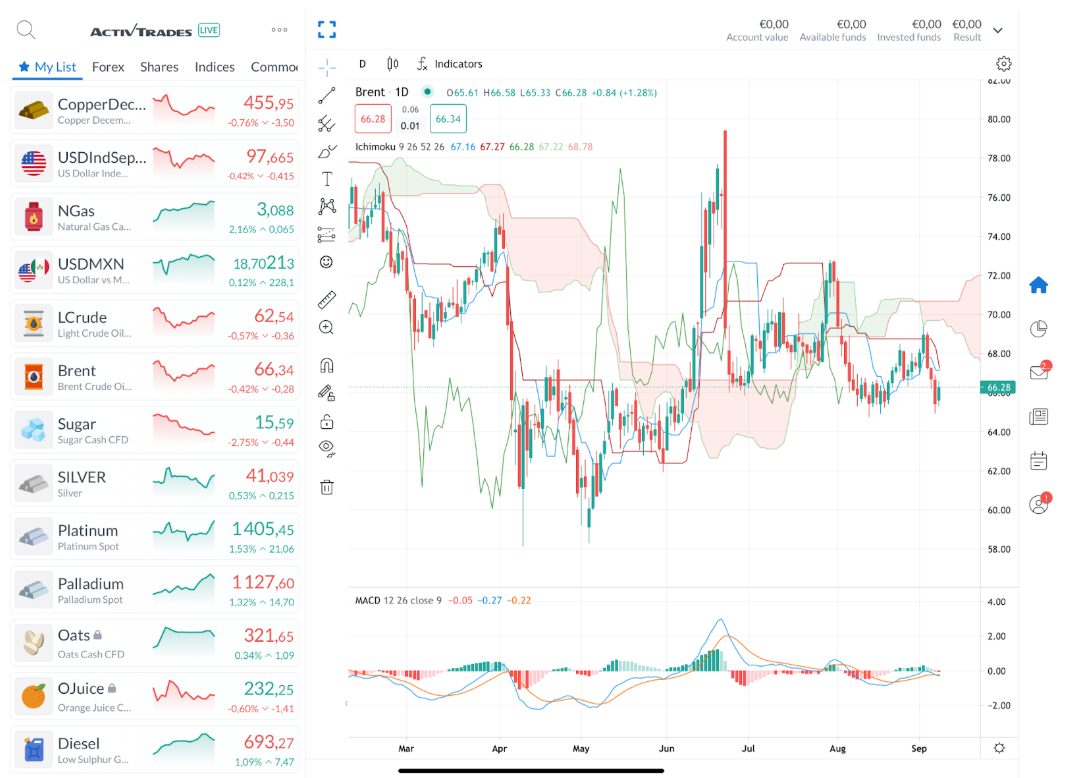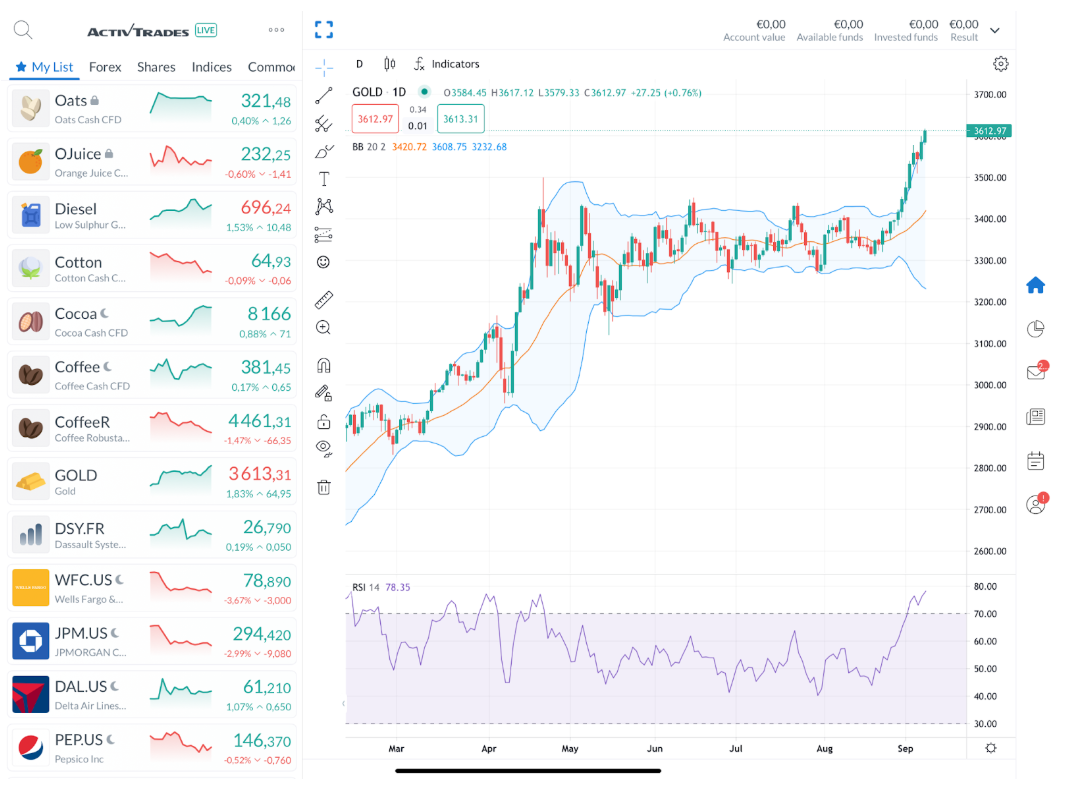Oil and Gold Climb as the Week Begins

Oil and gold kicked off the week with strong gains, setting the tone for what could be a volatile stretch in global markets. Brent crude rose more than 1.3%, while gold advanced over 0.7% to a fresh record above $3,611 during early European trading. Here’s what’s driving the rally.
Why OPEC’s Supply Hike Isn’t Cooling Oil Prices This TimeOil markets started the week on a firmer footing, with prices rising on Monday despite OPEC+’s decision to increase supply. Normally, an output boost from the cartel would put downward pressure on prices, but this time the dynamics are more complex, as geopolitics and demand shifts are playing a larger role.
On Sunday, OPEC+—a group led by Saudi Arabia and Russia that controls roughly half of global supply—announced that eight members, including Iraq, the UAE, Kuwait, Kazakhstan, Algeria, and Oman, would ease their voluntary cuts by about 137,000 barrels per day. This adjustment partially rolls back the 1.65 million barrels per day of voluntary cuts first introduced in April 2023. The alliance justified its decision by pointing to steady global growth, low inventories, and “healthy market fundamentals.” In other words, OPEC+ believes the market can absorb the extra barrels without tipping into oversupply.
Yet the announcement has not weighed on prices as much as expected. Brent and WTI futures actually climbed on Monday, a sign that traders are looking beyond the headline increase. Strong summer demand, particularly from China—which has been stockpiling crude aggressively—has kept inventories tight across OECD countries. This demand cushion has prevented the feared glut from materializing, at least for now.
Adding to the bullish backdrop are renewed sanctions risks. U.S. President Donald Trump said over the weekend that he is prepared to move into a “second phase” of sanctions on Russia, his clearest indication yet that Washington could target Moscow’s oil exports or penalize buyers of Russian crude. Such measures would directly disrupt global flows, given Russia’s role as one of the world’s top exporters. Even the possibility of fresh sanctions has already injected a risk premium into the market, offsetting OPEC+’s supply boost.
The combination of geopolitical uncertainty and resilient demand explains why oil prices are rising today instead of sliding. Analysts note that OPEC+’s strategy is increasingly about signaling rather than barrels: the group is prioritizing market share, even at the risk of softer prices in the future. Still, the real test will come in the final quarter of the year, when seasonal demand weakens and a potential glut could start showing up in data.
Goldman Sachs struck a cautious tone in a note to clients this weekend. The bank kept its Brent/WTI price forecast for 2025 unchanged but projected that by 2026 the market would slip into a modest surplus, with prices averaging $56 a barrel for Brent and $52 for WTI. Goldman cited rising supply in the Americas and weaker Russian exports, partially offset by stronger global demand.

Daily Brent Chart - Source: ActivTrades
Gold Surges on Rate Cut Expectations and Political UncertaintyThe rally in gold has been striking: prices are up 37% year-to-date after a 27% surge in 2024. With a weaker dollar, expectations of easier U.S. monetary policy, and geopolitical risks all in play, gold continues to shine as a hedge against uncertainty.
Gold prices climbed on Monday as traders bet more confidently on a Federal Reserve rate cut next week, following a surprisingly weak U.S. jobs report and intensifying political tensions in Washington. The precious metal, which has already had a stellar year, is drawing additional strength from mounting evidence of a slowing labor market, rising geopolitical risks, and questions over the Fed’s independence.
The August nonfarm payrolls report delivered a sharp downside surprise. Only 22,000 jobs were created last month, far short of economists’ expectations for 75,000 and a steep drop from July’s upwardly revised 79,000. The unemployment rate also rose to 4.3%, its highest in nearly four years, cementing the view that labor market conditions are cooling. Revisions to prior months painted an even weaker picture: June payrolls, initially reported as a gain of 14,000, were revised to show a loss of 13,000 jobs—the first monthly decline since December 2020.
The slowdown in hiring has been building since the spring. Over the past three months, job growth has averaged just 29,000 per month, compared with 82,000 during the same period in 2024. Economists point to multiple policy shocks weighing on business sentiment: President Donald Trump’s sweeping tariffs, his administration’s immigration clampdown, and large-scale layoffs of public workers have all combined to leave companies reluctant to hire.
For markets, the report all but seals the case for monetary easing. According to the CME FedWatch tool, traders have fully priced in a 25-basis-point cut at next week’s Fed meeting, with nearly a one-in-ten chance of an even larger 50-basis-point move. Since Gold doesn't pay interest, the commodity becomes a more appealing investment when rates are low and other assets offer potentially less return.
The bullish case for gold is further amplified by geopolitics and domestic political interference. Trump has continued to exert pressure on the Fed, not only by publicly criticizing policy but also by reshaping its leadership through his appointments—moves that investors fear could erode the central bank’s independence. Against this backdrop, safe-haven demand for bullion has accelerated.
Central bank demand has provided an additional tailwind, led by China, which extended its buying spree into a 10th straight month in August.

Daily Gold Chart - Source: ActivTrades
Source: Reuters, Wall Street Journal, OPEC, CME, BLS
-362025100.png)
-362025100.png)



















